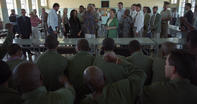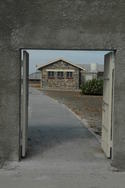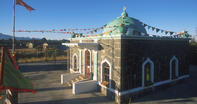The First Step Towards Freedom
In 1986, several legislative pillars of apartheid were repealed, such as the Mixed Marriages Act and the Pass Laws. Finally, in 1990, to the surprise and joy of South Africa opposition parties such as the African National Congress (ANC) and Pan African Congress (PAC) were unbanned and Mandela was released.

The years from 1990 until the first democratic elections of 1994 were historic. There were months of hard-fought negotiations and right-wing attempts to destabilise the country. Finally, and against the odds, a voluntary handover of power was achieved.
Often called the first ‘peaceful revolution’ in the world, it was the beginning of a new era in South African history. In 1988, when Mandela was moved to a house on the grounds of the Victor Verster Prison. By this time, the winds of change were blowing across the sub-continent and Mandela was again offered his freedom. He refused once more and insisted that his colleagues be released first, knowing that the crafty government might refuse to release the others once the ANC’s figurehead was free.
Accordingly, one by one, the other political leaders were abruptly released with little fanfare and no warning. On 2nd of February 1990, the world watched as Madiba and his wife Winnie walked hand-in-hand through the gates of Victor Verster and into the world. Following this momentous event, the remaining political prisoners on Robben Island were left in a state of confusion and excitement.
Rumours swirled around the prison and the government, rather cruelly, refused to issue any conclusive statement on the issue. Gradually, however, they were all granted their freedom and were unceremoniously released, with no counselling and no support, back into society.
Release of Political Prisoners

When the remaining political prisoner's were release, they were given no compensation for their time in prison, and had few prospects for employment. A number of ex-political prisoners subsequently turned to alcohol and substance abuse. Even today, there is still no substantial program to assist those who wasted away in the jails of apartheid.
By 1991, all of the political prisoners had left Robben Island. The facilities continued to serve as a prison for criminal prisoners until 1996, when it was finally decided to close the place down and relocate the remaining captives to jails on the mainland. The fate of Robben Island was once again unclear.
Importance of Robben Island

The importance of the island as a symbol of the struggle and as an icon of victory over injustice was being recognised. The decision was then taken to turn the entire island into a museum that would educate people about the evils of racism and the power of tolerance. The Museum officially opened on the 1st of January 1997.
In 1999, this initiative was endorsed by the international community when the island was inscribed into the World Heritage List. Today, thousands of people visit the former prison every week to experience for themselves the miraculous story of Robben Island.
It is not always a pleasant pilgrimage, but it is one that we should all undertake so that the painful lessons of the last 500 years are not forgotten. By keeping the memory of Robben Island we may, for once, prevent history from repeating itself.
By David Fleminger